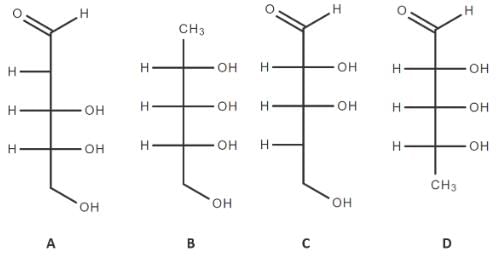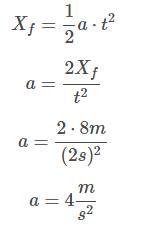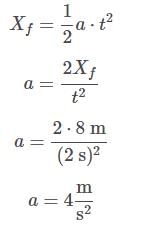Test: Chemistry - 2 - MCAT MCQ
15 Questions MCQ Test - Test: Chemistry - 2
A cell membrane defines the limits of the cell and serves as the boundary between the cell and its surroundings. It is made of a double layer of lipids that blocks the passage of polar substances. The image below shows a typical cell membrane:
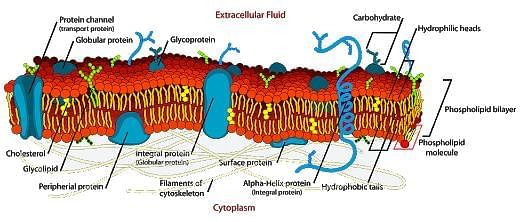
One important concept related to cell membranes is membrane fluidity. Cells need to keep a certain level of flexibility in order to maintain their stability. Increasing temperature, cholesterol content, and unsaturation of the fatty acid tail of the phospholipids in the bilayer increases the membrane fluidity.
Substances pass through the cell membrane by a process called “transport”. Transport can be passive if no energy is consumed or active if energy is required to transport substances across the membrane. The movement of an uncharged solute across a membrane depends on its concentration gradient, while the movement of an ion depends both on its concentration gradient and the electric potential of the membrane. Membranes are said to be polarized if the resting membrane potential is different than zero, depolarized if the membrane potential is higher than the resting membrane potential, and hyperpolarized if the membrane potential is lower than the resting membrane potential.
The following table shows the characteristics of the different types of solute transport across a membrane:

Q. Utilizing the attachment, if an organism needs to stay alive in a cold environment, what needs to change in the composition of its cell membrane?


A cell membrane defines the limits of the cell and serves as the boundary between the cell and its surroundings. It is made of a double layer of lipids that blocks the passage of polar substances. The image below shows a typical cell membrane:
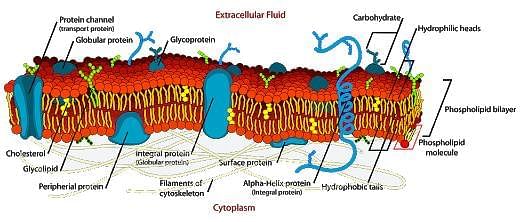
One important concept related to cell membranes is membrane fluidity. Cells need to keep a certain level of flexibility in order to maintain their stability. Increasing temperature, cholesterol content, and unsaturation of the fatty acid tail of the phospholipids in the bilayer increases the membrane fluidity.
Substances pass through the cell membrane by a process called “transport”. Transport can be passive if no energy is consumed or active if energy is required to transport substances across the membrane. The movement of an uncharged solute across a membrane depends on its concentration gradient, while the movement of an ion depends both on its concentration gradient and the electric potential of the membrane. Membranes are said to be polarized if the resting membrane potential is different than zero, depolarized if the membrane potential is higher than the resting membrane potential, and hyperpolarized if the membrane potential is lower than the resting membrane potential.
The following table shows the characteristics of the different types of solute transport across a membrane:

Q. The resting membrane potential of a neuron is about -60 mV. In an experiment the membrane potential of a neuron is measured to be -90 mV. This membrane is ____. (You may consult the attachment.)


A cell membrane defines the limits of the cell and serves as the boundary between the cell and its surroundings. It is made of a double layer of lipids that blocks the passage of polar substances. The image below shows a typical cell membrane:

One important concept related to cell membranes is membrane fluidity. Cells need to keep a certain level of flexibility in order to maintain their stability. Increasing temperature, cholesterol content, and unsaturation of the fatty acid tail of the phospholipids in the bilayer increases the membrane fluidity.
Substances pass through the cell membrane by a process called “transport”. Transport can be passive if no energy is consumed or active if energy is required to transport substances across the membrane. The movement of an uncharged solute across a membrane depends on its concentration gradient, while the movement of an ion depends both on its concentration gradient and the electric potential of the membrane. Membranes are said to be polarized if the resting membrane potential is different than zero, depolarized if the membrane potential is higher than the resting membrane potential, and hyperpolarized if the membrane potential is lower than the resting membrane potential.
The following table shows the characteristics of the different types of solute transport across a membrane:

Q. In bacteria, lactose can be transported inside the cell by a process called symport, in which the transport of lactose against its concentration gradient is coupled with the transport of protons down their concentration gradient from the outside to the inside of the cell. Which of the following is a false statement regarding lactose symport? (You may consult the attachment.)


A cell membrane defines the limits of the cell and serves as the boundary between the cell and its surroundings. It is made of a double layer of lipids that blocks the passage of polar substances. The image below shows a typical cell membrane:
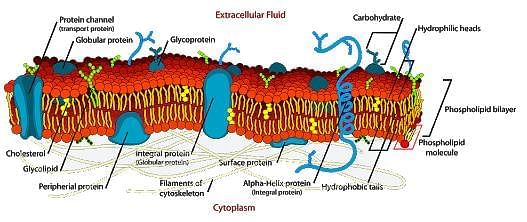
One important concept related to cell membranes is membrane fluidity. Cells need to keep a certain level of flexibility in order to maintain their stability. Increasing temperature, cholesterol content, and unsaturation of the fatty acid tail of the phospholipids in the bilayer increases the membrane fluidity.
Substances pass through the cell membrane by a process called “transport”. Transport can be passive if no energy is consumed or active if energy is required to transport substances across the membrane. The movement of an uncharged solute across a membrane depends on its concentration gradient, while the movement of an ion depends both on its concentration gradient and the electric potential of the membrane. Membranes are said to be polarized if the resting membrane potential is different than zero, depolarized if the membrane potential is higher than the resting membrane potential, and hyperpolarized if the membrane potential is lower than the resting membrane potential.
The following table shows the characteristics of the different types of solute transport across a membrane:

Q. When red blood cells are placed in a solution with a lower concentration of sodium ions, water molecules pass through the cell membrane from the outside to the inside of the cell in order to balance out the concentration of sodium ions. This is an example of what type of transport? (You may consult the attachment.)
A cell membrane defines the limits of the cell and serves as the boundary between the cell and its surroundings. It is made of a double layer of lipids that blocks the passage of polar substances. The image below shows a typical cell membrane:

One important concept related to cell membranes is membrane fluidity. Cells need to keep a certain level of flexibility in order to maintain their stability. Increasing temperature, cholesterol content, and unsaturation of the fatty acid tail of the phospholipids in the bilayer increases the membrane fluidity.
Substances pass through the cell membrane by a process called “transport”. Transport can be passive if no energy is consumed or active if energy is required to transport substances across the membrane. The movement of an uncharged solute across a membrane depends on its concentration gradient, while the movement of an ion depends both on its concentration gradient and the electric potential of the membrane. Membranes are said to be polarized if the resting membrane potential is different than zero, depolarized if the membrane potential is higher than the resting membrane potential, and hyperpolarized if the membrane potential is lower than the resting membrane potential.
The following table shows the characteristics of the different types of solute transport across a membrane:

Q. To maintain the concentration gradients of Na+ and K+, a special protein commonly known as the sodium-potassium pump is used. For every ATP molecule that is broken down by this protein, 2 K+ ions are moved from the outside to the inside of the cell, and 3 Na+ ions are moved from the inside to the outside of the cell. If there’s a certain condition that prevents the sodium-potassium pump from functioning properly, what will happen to the membrane? (You may consult the attachment.)
The branch of physics that studies the motion of a body without taking into account the causes of that motion is called kinematics. According to kinematics, the position and velocity of a moving body is described by the following equations:

Where Xo and Xf are the initial and final positions of the body, Vo and Vf are the initial and final velocities of the body, a is the acceleration of the body, and t is the time.
According to classical mechanics, developed by Isaac Newton, the product of the mass and the acceleration of a body can be described by the following equation (Newton’s second law):
m⋅a = ΣF
Where m is the mass, a is the acceleration, and ΣF is the sum of all forces acting on the body.
The following table shows the position at different times of a 80-kg hospital bed with a 40-kg patient on top of it that is being pushed from rest by a doctor on a rough floor that exerts a constant friction force of 600 N.
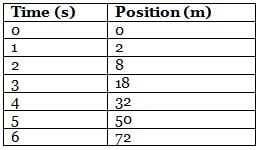
Q. According to the attached information, the hospital bed is moving according to what type of motion?
The branch of physics that studies the motion of a body without taking into account the causes of that motion is called kinematics. According to kinematics, the position and velocity of a moving body is described by the following equations:

Where Xo and Xf are the initial and final positions of the body, Vo and Vf are the initial and final velocities of the body, a is the acceleration of the body, and t is the time.
According to classical mechanics, developed by Isaac Newton, the product of the mass and the acceleration of a body can be described by the following equation (Newton’s second law):
m⋅a = ΣF
Where m is the mass, a is the acceleration, and ΣF is the sum of all forces acting on the body.
The following table shows the position at different times of a 80-kg hospital bed with a 40-kg patient on top of it that is being pushed from rest by a doctor on a rough floor that exerts a constant friction force of 600 N.
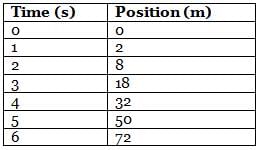
Q. In the attachment, what is the velocity of the hospital bed at t = 4s?
The branch of physics that studies the motion of a body without taking into account the causes of that motion is called kinematics. According to kinematics, the position and velocity of a moving body is described by the following equations:

Where Xo and Xf are the initial and final positions of the body, Vo and Vf are the initial and final velocities of the body, a is the acceleration of the body, and t is the time.
According to classical mechanics, developed by Isaac Newton, the product of the mass and the acceleration of a body can be described by the following equation (Newton’s second law):
m⋅a = ΣF
Where m is the mass, a is the acceleration, and ΣF is the sum of all forces acting on the body.
The following table shows the position at different times of a 80-kg hospital bed with a 40-kg patient on top of it that is being pushed from rest by a doctor on a rough floor that exerts a constant friction force of 600 N.
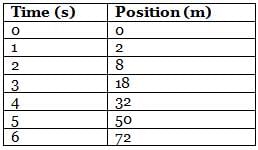
Q. What is the force exerted by the doctor on the bed in the attachment?
The branch of physics that studies the motion of a body without taking into account the causes of that motion is called kinematics. According to kinematics, the position and velocity of a moving body is described by the following equations:

Where Xo and Xf are the initial and final positions of the body, Vo and Vf are the initial and final velocities of the body, a is the acceleration of the body, and t is the time.
According to classical mechanics, developed by Isaac Newton, the product of the mass and the acceleration of a body can be described by the following equation (Newton’s second law):
m⋅a = ΣF
Where m is the mass, a is the acceleration, and ΣF is the sum of all forces acting on the body.
The following table shows the position at different times of a 80-kg hospital bed with a 40-kg patient on top of it that is being pushed from rest by a doctor on a rough floor that exerts a constant friction force of 600 N.

Q. What is the acceleration of the hospital bed in the attachment?
The branch of physics that studies the motion of a body without taking into account the causes of that motion is called kinematics. According to kinematics, the position and velocity of a moving body is described by the following equations:

Where Xo and Xf are the initial and final positions of the body, Vo and Vf are the initial and final velocities of the body, a is the acceleration of the body, and t is the time.
According to classical mechanics, developed by Isaac Newton, the product of the mass and the acceleration of a body can be described by the following equation (Newton’s second law):
m⋅a = ΣF
Where m is the mass, a is the acceleration, and ΣF is the sum of all forces acting on the body.
The following table shows the position at different times of a 80-kg hospital bed with a 40-kg patient on top of it that is being pushed from rest by a doctor on a rough floor that exerts a constant friction force of 600 N.
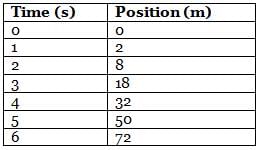
Q. What forces are acting on the hospital bed in the attachment?
If a free body diagram is drawn for the hospital bed, there are five forces acting on the hospital bed: The push by the doctor, pointing to the right; friction, pointing left; weight of the bed and weight of the patient, pointing down; and normal, pointing up.

Q. Which of the following compounds is a carbohydrate? (You may consult the attachment.)
If a free body diagram is drawn for the hospital bed, there are five forces acting on the hospital bed: The push by the doctor, pointing to the right; friction, pointing left; weight of the bed and weight of the patient, pointing down; and normal, pointing up.
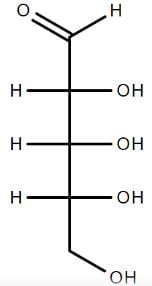
Q. What is the main functional group present in D-ribose? (See the attachment.)
DNA (deoxyribonucleic acid) is the information-storing biomolecule of the cell. The process by which the information stored in DNA can be converted into proteins can be broken down into three subprocesses:
Replication: In this process, a parent DNA strand is paired with its complementary strand. Adenine is paired with thymine, cytosine is paired with guanine, and vice-versa. In this way the information stored in DNA is preserved.
Transcription: In this process, DNA is separated and the complementary strand is copied into mRNA. Adenine is paired with uracil, cytosine is paired with guanine, and vice-versa. Translation: In this process, tRNA recognizes sequences of three bases in RNA called codons and transfers an amino acid into the growing protein chain that starts with the codon that codes for methionine. The codons are shown in the image below and are read starting from the center:

Q. Which parent DNA sequence will code for the polypeptide Met-Thr-Asp-Gly-Val? (You may consult the attachment.)
DNA (deoxyribonucleic acid) is the information-storing biomolecule of the cell. The process by which the information stored in DNA can be converted into proteins can be broken down into three subprocesses:
Replication: In this process, a parent DNA strand is paired with its complementary strand. Adenine is paired with thymine, cytosine is paired with guanine, and vice-versa. In this way the information stored in DNA is preserved.
Transcription: In this process, DNA is separated and the complementary strand is copied into mRNA. Adenine is paired with uracil, cytosine is paired with guanine, and vice-versa. Translation: In this process, tRNA recognizes sequences of three bases in RNA called codons and transfers an amino acid into the growing protein chain that starts with the codon that codes for methionine. The codons are shown in the image below and are read starting from the center:
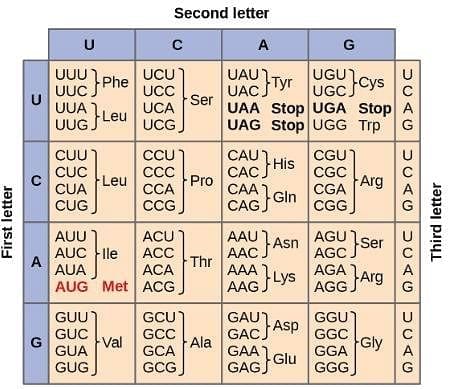
Q. Using the attachment, how many amino acids would be located on the polypeptide chain made from the sequence ATTATGCGTCAATGAATAAGACTG?
To form DNA, C′2 of ribose undergoes deoxygenation to remove the hydroxyl group. Which of the following diagrams marked in the attachment is the correct structure for deoxyribose?
